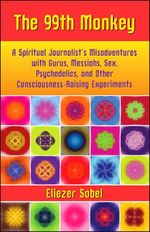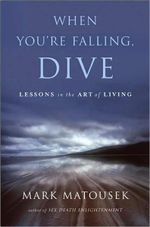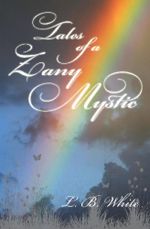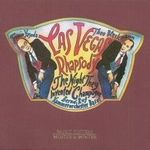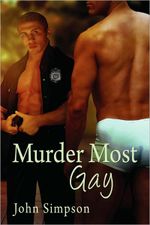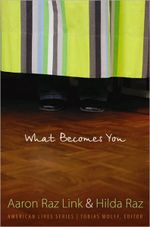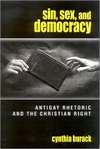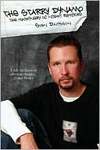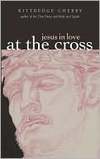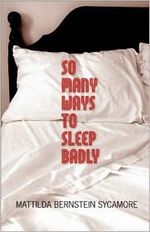 So Many Ways
So Many Ways
to Sleep Badly
By Mattilda Bernstein Sycamore
City Lights Publishers $15.95
ISBN-10: 0872864685, 256 pages
Reviewed by Steve Susoyev
A number of popular artists have fashioned their personal brands of neurosis into lucrative art forms. No matter how fucked up you feel on a given day, you may derive a certain comfort from the scene in Annie Hall in which Woody Allen rips up his driver’s license while explaining to a Los Angeles cop, “I have a terrific problem with authority, you know.”
In the realm of literary memoir, Anne Lamott’s agonizing descriptions of the drunken behavior with which she routinely alienated everyone in her early life who was worth caring about, and of her sometimes tortured relationship with her son Sam, now in his late teens, make me laugh so hard I have to pull off the road when I listen to her audio books in the car.
Mattilda Bernstein Sycamore, who appears here for the first time without the now-familiar “aka Matt” designation in her name, has catapulted the whore’s memoir into the neurosis genre. No Moll Flanders-style stories of deprivation or exploitation introduce So Many Ways to Sleep Badly. The paternal incest that has been thoroughly explored in Pulling Taffy and Dangerous Families makes brief, oblique appearances here: “When my mother says you need to go to the root of your problems — get me a shovel! Lilie says: I like when you talk about incest because you can laugh about it.” And, “Why am I so fucking fragile? I’ll give you three choices: “(a) Incest. (b) Incest. (c) Incest.”
In what often feels like free-association but is in fact cleverly crafted narrative, this very savvy writer and social commentator manages, both in her novels and essay collections, to sound utterly clueless while skewering hypocrites and herself. We get earfuls about unsafe sex, sexual compulsion and meth addiction, Gay marriage and other symptoms of self-annihilating Gay assimilation, police brutality, and the outrageous prices of organic produce offered at designer supermarkets.
And so much more.
Readers who have not encountered Mattilda at her readings or read her other work may be surprised to find her unique even among gender-bending writers, displaying none of the indignation with which many M‑F trannies approach the subject of other people’s confusion concerning their sexual identities. Mattilda prefers to be called “She,” but in this volume we find frequent references to her penis, one of the chief tools of her trade as a whore: “I like the way this trick’s whole body clenches then releases every time my dick goes in and out of his ass.” Scenes from Mattilda’s sex career appear and retreat mid-paragraph, leaving the reader with the impression that tricks go and come in the slapdash way that wrestling competitions and Brazilian soap operas appear on the television screens of the late-night channel-surfer, between bites from slices of stale pizza and calls to the phone-sex lines.
Mattilda’s essays, and her introductions to the essay collections that she has edited, are incisive and focused. Her Foreword to the 2007 Lammy-nominated Nobody Passes hisses with outrage at GUPPYS in Bermuda shorts whose greatest aspiration — whose only apparent aspiration — is to assimilate utterly with their straight neighbors, preferably through the patriarchal institution of marriage. No matter where you stand on the marriage issue, this glitter-eyed, gender-bent, metallic-mesh-encased kid with the feathers in his/her hair will make you think.
If you’ve ever paid for sex, and wondered what sex workers think of their clients, after reading one of Mattilda’s novels you’ll remind yourself to be careful what you ask for:
This trick could be fun, except he’s so nervous I can’t stay hard, and his crotch smells like rotten eggs…. He’s one of those tricks who thought I was shorter, from the one-column-inch photo in the paper…. He pays me one-forty-eight plus two dollars in quarters…. Funny how the guy won’t kiss me afterwards, honey it’s your come…. It’s a good thing this guy’s dick is beautiful, because he’s — well, you know….
And so a fan of Mattilda’s politically charged essays could think we’re in some unfamiliar territory here. But politics is never far under the surface:
On my way home, the 7th and Market 24-hour check-cashing place is jammed and the cops drive up and arrest two black guys who are just standing there. The cop car drives off and then this one white guy chases after the only other white guy there with a baseball bat — racial profiling is so effective!
Despite the free-associative impression, the book has a plot, a theme, and a message. Of course it would be easy to read So Many Ways… as pure autobiography, particularly because our fictional narrator calls herself “Mattilda,” works as a whore, and has strong opinions. But in the temporally disoriented, casino-like world in which our narrator meets and dismisses tricks, haunts sex clubs, cruises parks, falls in love, tosses in bed until daybreak, frets about her digestion and other health issues, suffers heartbreak and disses hypocrites, the one thing she does not do is write. Unlike this fictional narrator, Mattilda Bernstein Sycamore is a prolific writer. And so, to whatever extent these vignettes from the fictional life of a neurotic, politically savvy whore are taken from the experience of the neurotic, politically savvy whore whose name appears on the title page, the thing the narrator does not share with us is her experiences as a writer and performance artist.
If City Lights Books ever releases Mattilda’s work in audio form, they surely will have the sense to make sure she reads it herself. In the meantime, catch her reading live whenever you can. She has learned much as a performer — with some tips, I think, from her friend the performance artist and whore Kirk Read. Her comic timing and the crackling intelligence of her ironic phrasing will bring you to your knees.
Steve Susoyev lives in San Francisco.
This is an excerpt. Subscribe today and keep the conversation going! Consider giving a gift subscription to your friends who could use some wisdom! This is anIf there's an article listed above that was not excerpted online, copies of this issue are available for purchase. Contact us at editors@gaywisdom.org
